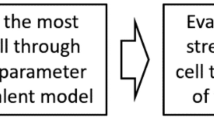Abstract
This paper presents results from a numerical and experimental investigation motivated by the need to explore the effectiveness of residual stress relief techniques in aluminium alloy engineering components of complex geometry. Quenching is part of the heat treatment to establish mechanical properties. It can create high levels of residual stress in an engineering component. Finite element analysis (FEA) was used to predict the residual stresses generated by quenching and the location of peak residual stresses corresponding to probable in service failure sites. The residual strains and stresses were characterised using neutron diffraction techniques in components with high and low quench stresses to validate a FEA study, and also to appraise the evolution of a commercial stress relief method. An excellent correlation existed between the simulations and measurements.






















Similar content being viewed by others
Data availability
Data and material are not provided with the article.
References
ABAQUS (2012) Analysis User’s Manual. Version 6.12, Dassault Systemes Simulia, Inc.
Bray DP et al (2007) Use of ABAQUS for the Simulation of Manufacturing Processes. ABAQUS Users Conference, Paris
Fitzpatrick, M.E., & Lodini, A. (Eds.) (2003) Analysis of Residual Stress by Diffraction using Neutron and Synchrotron Radiation (1st ed.). CRC Press. https://doi.org/10.1201/9780203608999
Hossain S (2005) Residual stresses under conditions of high triaxiality, Ph.D. Thesis, University of Bristol, UK. Available at: https://ethos.bl.uk/OrderDetails.do?uin=uk.bl.ethos.424402
Hossain S, Truman CE, Smith DJ, Peng RL, Stuhr U (2007) A study of the generation and creep relaxation of triaxial residual stresses in stainless steel. Int J Solids Struct 44:3004–3020
Hutchings MT, Withers PJ, Holden TM, Lorentzen T (2005) Introduction to the characterisation of residual stress by neutron diffraction. CRC Press, Boca Raton, p 424
James MN (2011) Residual stress influences on structural reliability. Eng Fail Anal 18(8):1909–1920. https://doi.org/10.1016/j.engfailanal.2011.06.005
Lewis SJ et al (2011, 2011) Determination of Remnant Residual Stresses in Fracture Toughness Specimens Extracted From Large Components. 47(1):e333–e343. https://doi.org/10.1111/j.1475-1305.2009.00614.x
Pan R, Pirling T, Zheng J, Lin J, Davies CM (2019) Quantification of thermal residual stresses relaxation in AA7xxx aluminium alloy through cold rolling. J Mater Process Technol 264:454–468
Ramesh G, Narayan Prabhu K (2016) Effect of Polymer Concentration on Wetting and Cooling Performance During Immersion Quenching. Metall Mater Trans B 47:859–881. https://doi.org/10.1007/s11663-015-0541-5
Robinson, J. (2007) Measurement of the heat transfer coefficient during quenching of the aluminium alloy 7449, Internal COMPACT deliverable report D2a.1.2, Unpublished
Sen S, Aksakal B, Ozel A (2000) Transient and residual thermal stresses in quenched cylindrical bodies. Int J Mech Sci 42:2013–2029
Senatorova OG, Sidelnikov VV, Mihailova IF, Fridlyander IN, Bedarev AS, Spector JI, Tihonova LA (2002) Low Distortion Quenching of Aluminium Alloys in Polymer Medium. Mater Sci Forum 396–402:1659–1664. https://doi.org/10.4028/www.scientific.net/msf.396-402.1659
Song J, Zhang Y (2016) Effect of vibratory stress relief on fatigue life of aluminum alloy 7075- T651. Adv Mech Eng 8(6):1–9. https://doi.org/10.1177/1687814016654379
Stuhr U (2005) Time of flight diffraction with multiple pulse overlap; Part I: the concept. Nucl Instrum Methods A 545:319–329
Stuhr U, Grosse M, Wagner W (2006) The TOF-strain scanner POLDI with multiple frame overlap—concept and performance. Mater Sci Eng A 437(1):134–138. https://doi.org/10.1016/j.msea.2006.04.069
Withers PJ (2007) Residual stress and its role in failure. Rep Prog Phys 70(12):2211–2264. https://doi.org/10.1088/0034-4885/70/12/R04
Yang Y (2009) Understanding of Vibration Stress Relief with Computation Modeling. J Mater Eng Perform 18:856–862. https://doi.org/10.1007/s11665-008-9310-9
Zainulabdeen AA et al (2018) IOP Conference Series: Materials Science and Engineering, vol 454. International Conference on Materials Engineering and Science, Istanbul
Zheng J-H, Pan R, Wimpory RC, Lin J, Li C, Davies CM (2019) A novel manufacturing process and validated predictive model for high-strength and low-residual stresses in extra-large 7xxx panels. Mater Des 173:107767
Acknowledgements
For this work, we are grateful for the use of the experimental facilities at SINQ, Paul Scherrer Institute. This research project has been supported by the European Commission under the 6th Framework Programme through the Key Action: Strengthening the European Research Area, Research Infrastructures. Contract number: RII3-CT-2003-505925.
Funding
This research has been supported by the European Commission under the 6th Framework Programme through the Key Action: Strengthening the European Research Area, Research Infrastructures. Contract number: RII3-CT-2003-505925.
Author information
Authors and Affiliations
Contributions
By comparing numerical prediction with experimentally measured stresses by neutron diffraction technique, the finite element analysis (FEA) study was validated, and the effectiveness of stress relief technique explored. FEA predicted the residual stress generated by quenching and the location of peak residual stresses corresponding to probable failure sites.
Corresponding author
Ethics declarations
Code availability
Not applicable
Conflict of interest
The authors declare that they have no conflict of interest.
Additional information
Publisher’s note
Springer Nature remains neutral with regard to jurisdictional claims in published maps and institutional affiliations.
Rights and permissions
About this article
Cite this article
Hossain, S., Stuhr, U., Robinson, J.S. et al. Validating quench stresses in complex aluminium components. Int J Adv Manuf Technol 113, 3555–3567 (2021). https://doi.org/10.1007/s00170-021-06831-y
Received:
Accepted:
Published:
Issue Date:
DOI: https://doi.org/10.1007/s00170-021-06831-y




